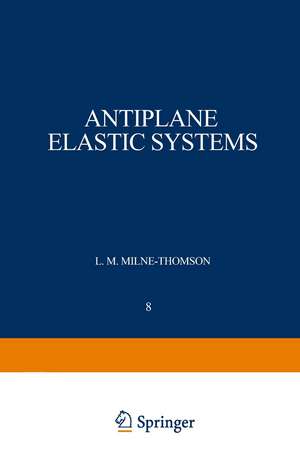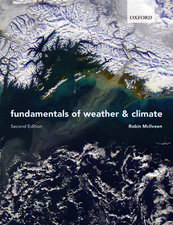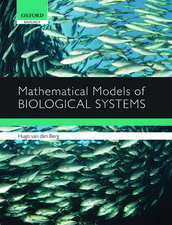Antiplane Elastic Systems: Ergebnisse der angewandten Mathematik, cartea 8
Autor Louis M. Milne-Thomsonen Limba Engleză Paperback – 1962
Din seria Ergebnisse der angewandten Mathematik
-
 Preț: 452.25 lei
Preț: 452.25 lei -
 Preț: 412.13 lei
Preț: 412.13 lei - 15%
 Preț: 435.77 lei
Preț: 435.77 lei -
 Preț: 411.75 lei
Preț: 411.75 lei -
 Preț: 348.77 lei
Preț: 348.77 lei -
 Preț: 385.62 lei
Preț: 385.62 lei -
 Preț: 381.43 lei
Preț: 381.43 lei
Preț: 386.22 lei
Nou
Puncte Express: 579
Preț estimativ în valută:
73.91€ • 80.26$ • 62.09£
73.91€ • 80.26$ • 62.09£
Carte tipărită la comandă
Livrare economică 23 aprilie-07 mai
Preluare comenzi: 021 569.72.76
Specificații
ISBN-13: 9783540028055
ISBN-10: 3540028056
Pagini: 276
Ilustrații: VIII, 266 p.
Dimensiuni: 152 x 229 x 14 mm
Greutate: 0.37 kg
Ediția:Softcover reprint of the original 1st ed. 1962
Editura: Springer Berlin, Heidelberg
Colecția Springer
Seria Ergebnisse der angewandten Mathematik
Locul publicării:Berlin, Heidelberg, Germany
ISBN-10: 3540028056
Pagini: 276
Ilustrații: VIII, 266 p.
Dimensiuni: 152 x 229 x 14 mm
Greutate: 0.37 kg
Ediția:Softcover reprint of the original 1st ed. 1962
Editura: Springer Berlin, Heidelberg
Colecția Springer
Seria Ergebnisse der angewandten Mathematik
Locul publicării:Berlin, Heidelberg, Germany
Public țintă
ResearchCuprins
I. The Law of Elasticity.- 1.1. Continued dyadic products.- 1.2. The stress tensor.- 1.3. The deformation tensor.- 1.4. The equation of motion.- 1.5. Internal energy.- 1.6. Elastic deformation.- 1.7. Hooke’s law.- 1.8. Anisotropy.- 1.9. Elastic symmetry.- Examples I.- II. Stress functions and complex stresses.- 2.0. Introductory notions.- 2.1. Stress functions and fundamental stress combinations.- 2.3. The displacement.- 2.4. The strain-energy function.- 2.5. The elimination of the displacements.- 2.6. The complex stresses.- 2.7. Expression of the fundamental stress combinations in terms of the complex stresses.- 2.8. Effective stress functions.- 2.9. The shear function.- Examples II.- III. Isotropic beams.- 3.1. The boundary conditions for a prismatic beam.- 3.2. The isotropic beam.- 3.3. Classification of certain antiplane problems.- 3.4. The equations which give the displacement in pure antiplane stress.- 3.5. The boundary condition for the pure antiplane problem for isotropic beams.- 3.6. Simple extension.- 3.7. Bending by terminal couples.- 3.8. Circular cylinder pushed into a hole.- Examples III.- IV. The torsion of isotropic beams.- 4.1. The torsion problem.- 4.2. Lines of shearing stress.- 4.3. The twisting moment.- 4.4. Solution by conformal mapping.- 4.5. The $$ z\bar z $$method.- 4.6. Boundary conditions.- 4.7. A uniqueness theorem.- 4.8. The principle of virtual stresses.- 4.9. Torsion of a compound bar of isotropic materials.- Examples IV.- V. The flexure of isotropic beams.- 5.1. The flexure problem.- 5.2. The centre of flexure.- 5.3. Half-sections.- 5.4. Shear stress functions.- 5.5. de St. Venant’s flexure function.- Examples V.- VI. Antiplane of elastic symmetry.- 6.1. Bending by couples.- 6.2. Boundary conditions.- 6.3. A device for transformingintegrals.- 6.4. Simplifying assumptions.- 6.5. Antiplane of elastic symmetry.- 6.6. The striess component zz.- 6.7. Orthotropic material.- 6.8. Methods of approximation.- Examples VI.- VII. General linear and cylindrical anisotropy.- 7.1. Generalized plane deformation.- 7.2. Line force applied to an elastic half-plane.- 7.3. Induced mappings for the region exterior to an ellipse.- 7.4. Bending of a cantilever by a transverse force at the free end.- 7.5. Cylindrical anisotropy.- 7.6. Equations satisfied by the stress functions.- 7.7. Circular tube under pressure.- Examples VII.- References.














